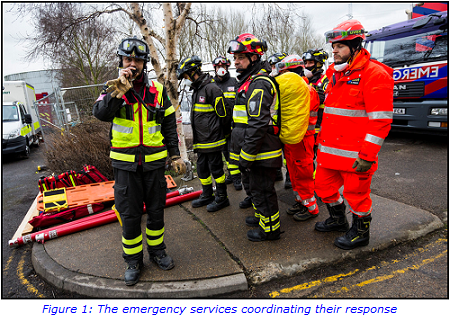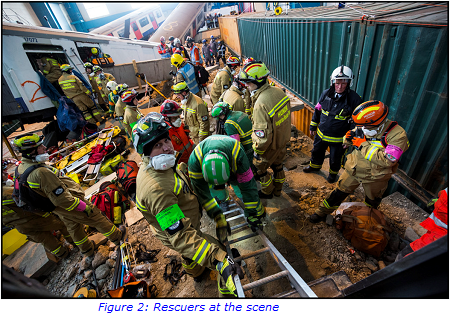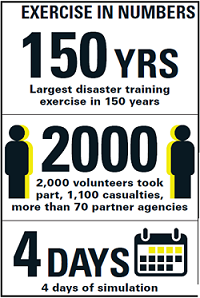Major incident simulation & planning
All laboratories providing acute services to the NHS have major incident plans which are carefully worked through strategies detailing the laboratory, team and individual responsibilities. They involve an element of second-guessing what, who and when resources will be needed and then attempt to build these into practice, ready for any eventuality. The overall objective is to provide reassurance that, in the event of a major, mass casualty event, every cog in the wheel will work as expected, to deliver the right standard of care, at the right time, independent of demand and time of day.
David Wells, Viapath’s Operations Director for Reference Services, explains: “Having sat through many desk-top exercises, it was a rare opportunity to be able to run through a full major incident, not only with more than one agency, but also ‘live’ with a fully operational laboratory and hospital. When the Viapath Laboratories at St Thomas’ hospital were approached to play their part in this exercise, Viapath’s Blood Transfusion Team jumped at the chance.”
Jess Child, Resilience Manager at Guy’s and St Thomas’ NHS Foundation Trust, picks up the story. “Exercise Unified Response” was a Europe-wide exercise that was run by the London Fire Brigade in March 2016. It provided the opportunity to test the Trust’s Major Incident/Mass Casualty Plan with a live simulation.”
The scenario
The exercise was based on a mass casualty incident, caused by a building collapse at London Waterloo train station, resulting in buried tube trains and requiring casualty extraction by urban search and rescue teams.
This high-profile exercise was attended by all of London’s emergency services. The exercise was set in the disused Littlebrook Power Station in Dartford, which was remodelled as London Waterloo station with 2,000 volunteers participating. Over four days of live play, 1,100 casualties were extracted from the scene and flowed into a notional hospital and disaster victim mortuary. As part of the planning, the Resilience Management Team worked with key players, including Viapath’s pathology laboratories, to ensure all aspects of the trauma pathway management were involved and their corresponding action cards tested and validated.
Realism was key
On March 2nd, a group of casualties, with agreed injury loading, played by paramedic students from the Institute of Pre-Hospital Care at London’s Air Ambulance/Queen Mary’s University London, flowed into the Emergency Department (ED). Six core patients were picked for evaluation and other patients were also added to the scenario. These included patients requiring code red blood transfusion, abdominal trauma, pregnancy and attending uninjured “relatives” who required support. Realism was key, so the casualties had simulated trauma injuries. The air of realism was further achieved by the Trust’s Simulation and Interactive Learning Centre whose role was to facilitate the use of patient monitoring to simulate clinical observations, which required the clinicians to make real-time decisions to manage clinical presentation.
Jess’ Resilience Management Team played a key role in maintaining continuity of ED service during the exercise, with the lead facilitator based at the ambulance doors to maintain exercise timings and pause live play when a real emergency patient required access.

It was very important not to disrupt the normal activity of ED and robust communications were key in this process. All ED patients were informed that a live exercise was taking place and walk-in patients were given leaflets. The Resilience Management Team also worked closely with the trust communications team to ensure information about the exercise was disseminated appropriately.
The blood bank
As part of the planning team, Tim Maggs, Viapath’s Blood Transfusion Laboratory Manager at Guy’s and St Thomas’, explains the laboratory’s role. “We were approached about taking part and were really keen to fully test the laboratory’s ability to manage the diagnostic and transfusion demands during a major incident. There was no attempt to alter the ‘business as usual’ level of processing and samples from real patients and these continued appropriately. Continuous review of the department’s ability to cope was undertaken by observers to ensure patient care wasn’t compromised”.
“In essence, the blood bank’s initial response to the incident involved the deployment of a ‘mobile blood bank’ containing boxes of universal donor blood to the ED department, which was managed by the nominated Blood Transfusion Coordinator. This allowed instant dispensing of universal donor red cells for immediate red cell replacement and, importantly, a mechanism through which all subsequent orders for blood components were placed in the ED. The Transfusion Coordinator liaised with the central blood bank for supply of plasma and platelets and also for re-supply of universal donor blood. In the meantime, the blood bank was redeploying teams, reviewing and replenishing stock and clearing any blood requests to prepare for patients as they flowed through to theatres and intensive care units.”
“In order to make the exercise as real as possible, a ghost blood stock was created on the non-live environment of the laboratory informatics system. Units of red cells, plasma, platelets and cryoprecipitate were photocopied and the ‘paper’ units deployed. As requests came in, the paper units were issued, boxed and crashed to the requesting locations. During a busy night in the blood bank, you could get three code red patients simultaneously over a 12-hour shift. During the exercise, we were exposed to six simultaneous code red patients – all before lunch time!”

The debrief
Tim explains the debrief process. “Although the laboratory responded extremely well, there were useful learning opportunities for the team involved on the day and relating to wider process, equipment and environment evaluation.
“Once the exercise had been stood down, we gathered our team for a debriefing session. From a blood bank point of view, the most challenging aspect of a major incident is clear and concise communication between the clinical teams and the laboratory, and establishing a single point of contact. While within the laboratory, keeping track of urgent requests for multiple patients is extremely challenging.”
 The Resilience Management Team also captured patient experience feedback during the exercise. Every “patient” in the exercise was followed through their journey by a clinical facilitator who audited the patient’s care and met with them to discuss their experience at the end of the exercise. Feedback was very positive with patient dignity, reassurance and clear explanations of what was happening described as being well managed. It was noted that the ability of the Trust to run the exercise live, through the working ED with realistic casualty simulations and with control rooms fully operational, added significantly to the understanding of major incident response, command and control, and trauma management.
The Resilience Management Team also captured patient experience feedback during the exercise. Every “patient” in the exercise was followed through their journey by a clinical facilitator who audited the patient’s care and met with them to discuss their experience at the end of the exercise. Feedback was very positive with patient dignity, reassurance and clear explanations of what was happening described as being well managed. It was noted that the ability of the Trust to run the exercise live, through the working ED with realistic casualty simulations and with control rooms fully operational, added significantly to the understanding of major incident response, command and control, and trauma management.
David Wells says: “From the laboratory’s point of view, this exercise was a visual interpretation of our major incident plan, bringing it to life, showing who we would be liaising with, how often, and when. It also demonstrated how our processes would work, what the impact would be upon the routine service, and most importantly, how effective we would be in the event of a mass casualty event. Working with our partners, we have found it incredibly reassuring to be able to put our plan into action and thoroughly test it, it’s the plan that we all hope we will never need to use, but if we do, we know we are ready.” He concludes: “As one of the observers during the event, it was humbling to see the professionalism, dedication and aptitude of the individuals who might one day save your life.”
Jess Child – Resilience Manager, Guy’s and St Thomas’ NHS Foundation Trust
Tim Maggs – Blood Transfusion Laboratory Manager, Viapath, Guy’s and St Thomas’ Hospital
David Wells – Director of Operations, Reference Service, Viapath, Guy’s and St Thomas’ and King’s College Hospitals


